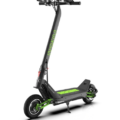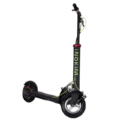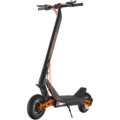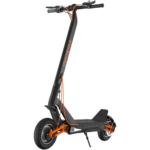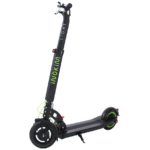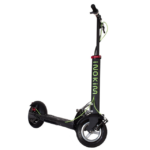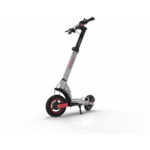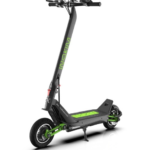- Home
- Scooters
- Electric Scooters
- INOKIM Mini 2
INOKIM Mini 2
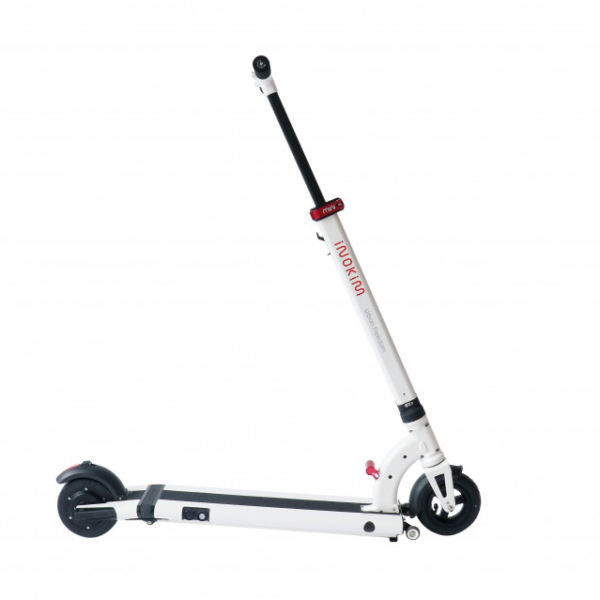


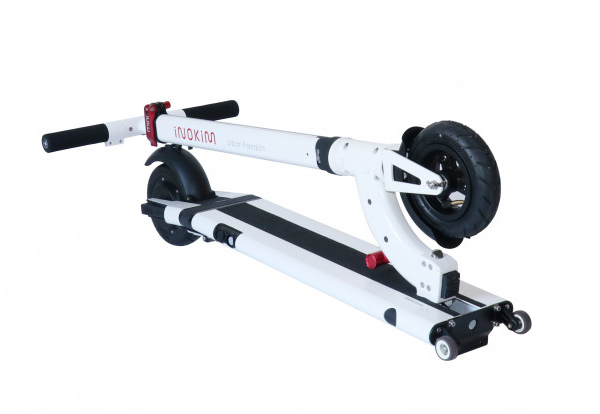
- Battery Range: 14–17 miles (23–28 km)
- Top Speed: 15 mph (25 km/h)
- Motor Power: 250 W
- Weight Capacity: 165 lb (75 kg)
- Charging Time: ≈4 h
- Scooter Weight: 23.0 lb (10.5 kg)
PROS
- Ultra-portable 23 lb (10.5 kg)
- Front 6″ pneumatic tire + rear solid
- Rear suspension damper
- Built-in trolley wheels
- Telescopic adjustable stem
CONS
- No built-in head/taillights
- Lower 165 lb (75 kg) load rating
- Small wheels less comfortable on rough roads
Key Takeaways
- The INOKIM Mini 2 is an ultra-portable electric scooter designed for quick city rides and easy transport.
- It features a 250 W rear hub motor, a 36 V battery, and a claimed range of 23-28 km.
- The scooter includes foldable mechanics and trolley wheels for convenient handling in urban settings.
- Its design emphasizes low weight (10 kg) and compact size, making it ideal for students and commuters alike.
- However, it is not suitable for heavy riders, long commutes, or wet conditions.
Table of contents
- What Is the INOKIM Mini 2?
- How the INOKIM Mini 2 Works
- Key Specifications
- Design & Build Quality
- Performance Fundamentals
- Battery, Range & Efficiency
- Ride Quality & Comfort
- Braking & Safety Features
- Portability & Daily Usability
- Maintenance & Care
- Weather & Seasonal Considerations
- INOKIM Mini 2 vs Alternatives
- Who the INOKIM Mini 2 Is (and Isn’t) For
- FAQs
- Glossary
The INOKIM Mini 2 is a tiny, sturdy electric scooter for short city hops. It leans hard into low weight, quick folding, and easy rolling in trolley mode. City riders, students, and multi-modal commuters will like the simple controls and steady manners. So if you want a quick last-mile ride you can carry with one hand, this nails it.
What Is the INOKIM Mini 2?
This scooter sits at the ultra-portable end of INOKIM’s range. It runs a 36 V system and a 250 W rear hub motor. The deck is slim and the frame uses aircraft-grade aluminum. It folds fast, then stands on small trolley wheels for stations and hallways. The front tire is air-filled, but the rear tire is solid. That mix keeps flats rare at the back and softens the front contact patch.
Top speed is rated at 25 km/h (15.5 mph). Claimed range lands around 23–28 km (14–17 mi). The scooter weighs about 10 kg (22.0 lb), so most people can lift it without strain. The load rating favors lighter riders, and that fits the last-mile brief. We rely on the official specifications throughout.
How the INOKIM Mini 2 Works
Motor and controller. A 250 W gearless hub motor sits in the rear wheel. Picture a quiet, sealed can with coils and magnets. The controller meters power in small steps, and starts feel smooth, not jumpy. Short bursts rise above the nominal rating, so small ramps and curbs feel easier.
Battery. A 36 V, 7.8 Ah lithium pack sits in the deck. Total energy is about 281 Wh, and that suits short urban rides. The charge port takes a 42 V, 2 A charger, so a full charge from low takes about four hours.
Throttle. The thumb throttle gives steady control, and a quick kick-start wakes the system. Then the scooter pulls away with a gentle rise in torque. Two modes change the top speed ceiling. Green mode caps speed for calmer riding, and Blue mode opens the full rating.
Brakes. Front electronic braking (EABS) adds a light, smooth drag when you ease off the throttle or tap the lever. The rear fender acts as a friction brake. Step down, and the fender presses a pad into the tire. So you get two layers of stopping power. Use both together for best results.
Key Specifications
The table groups the most relevant numbers and features. Imperial values appear in parentheses. These specifications match the standard Mini 2 setup.
| Block | Item | Value |
|---|---|---|
| General | Model | INOKIM Mini 2 |
| Frame material | AL6061/6063 aluminum | |
| Weight | 10 kg (22.0 lb) | |
| Max rider load | ≤ 75 kg (165 lb) | |
| Performance & Power | Top speed | 25 km/h (15.5 mph) |
| Motor | 250 W gearless rear hub, ~450 W peak | |
| Drive | Rear-wheel, single motor | |
| Battery, Charging & Electrical | Battery | 36 V, 7.8 Ah, ~280.8 Wh |
| Charger | 42 V, 2 A | |
| Charge time | ~4 hours | |
| USB output | 5 V, 1 A (on cockpit) | |
| Build & Dimensions | Unfolded size | 100 × 38.4 × 113.5 cm (39.4 × 15.1 × 44.7 in) |
| Folded size | 96 × 38.4 × 30 cm (37.8 × 15.1 × 11.8 in) | |
| Tires | Front 6 in pneumatic, rear 6 in honeycomb rubber | |
| Suspension | Rear elastomer element under deck | |
| Safety & Control | Braking | Front EABS + rear foot friction brake |
| Tire pressure guide | Do not ride if front tire is below ~35 psi | |
| Lighting | Basic, varies by batch; add brighter lights for night | |
| IP rating | Not stated; avoid wet use | |
| Features & Extras | Folding | Quick clamp with folding T-bar; screw-in grips |
| Trolley wheels | Yes, built-in; stand-up storage supported | |
| Cruise control | No | |
| Warranty & Compliance | Warranty | Commonly 1-year limited parts support from retailers |
| Compliance notes | Lithium battery shipping class; follow local rules |
Design & Build Quality
The frame uses aircraft-grade aluminum with a clean matte finish. Edges feel smooth, and the latch hardware clicks with a solid seat. The T-bar rises with a quick-release collar, and the grips screw in tight. The deck is narrow yet long enough for a staggered stance, so you can ride with one foot ahead of the other.
Fit and finish land well for the class. Gaps stay even, and the paint shrugs off light scuffs. The charge port has a snug cap that keeps dust out. The rear elastomer adds a little give on seams or bricks, and it knocks the harsh edge off tiny hits. It won’t turn rough roads plush, yet it helps on daily paths.
The trolley wheels are the star. Fold the bar, hook it into the rear fender, and tilt the scooter by the stem. Then it rolls like carry-on luggage. That small touch makes train stops, elevators, and store aisles easier and quicker.
Performance Fundamentals
Starts and low-speed control. Starts feel smooth in both modes, and the first meter comes with steady pull. So you can push off from a crosswalk without twitch. The throttle map keeps the front end calm, and that helps on crowded paths.
Cruising and straight-line stability. The short wheelbase tracks straight at 15–20 km/h on clean pavement. At higher speed you will feel small nudges from cracks and joints. The front air tire softens that chatter, and a relaxed grip tames bar feedback. Keep your weight light on the arms and soft in the knees, then the chassis rides true.
Hills. On 7–10% grades, expect a slow-but-steady climb. The scooter holds speed on short rises for lighter riders, but speed tapers on longer ramps. So plan a kick or two to help on steeper segments. The rear hub stays quiet, and heat build-up stays mild at the stated power level.
Noise and vibration. The hub is near silent, and tire noise is the main sound. You may hear deck buzz on rough pavers, yet the rear elastomer trims some of that. Tighten the quick release and check the hinge bolts now and then, then squeaks stay away.
Battery, Range & Efficiency
The 36 V, 7.8 Ah pack stores about 281 Wh, and the system sips power at city speeds. On flat ground with a 60–70 kg rider, real range often lands near the middle of the claimed window. Terrain and temperature matter, and headwinds raise draw. So your day-to-day distance will swing.
Charging. The 42 V, 2 A charger takes roughly four hours from low. The pack likes partial charges, and that habit helps long-term health. First, avoid parking it full for weeks. Next, avoid leaving it empty. Aim to store it around 40–70% if you will not ride for a while, then top it before the next ride.
Range habits that help. Keep speeds moderate, and keep tires at proper pressure. Plan gentle starts, then coast early toward lights. The light EABS can scrub a bit of speed before you step on the fender. So you waste less energy and keep stops smooth.
Ride Quality & Comfort
Tires. The 6 in front pneumatic tire grips better than a matching solid tire, and it smooths tiny bumps at the bar. The rear honeycomb tire never flats, so upkeep stays low. Small wheels hit potholes hard. Pick clean lines, slow for gaps, and keep your eyes up.
Suspension. The rear elastomer adds a small cushion. It works best on repeated chatter from brick, boardwalks, and tile, and it does not remove big hits. The deck sits low, so the stance feels stable at city speeds.
Ergonomics. Bar height adjusts quickly, and the grips feel secure. The deck is slim, so your toes sit near the front edge. That stance loads the front tire and sharpens steering feel. Stem flex stays modest when the latch is tight, and it stays that way if you keep bolts snug.
Braking & Safety Features
You get front electronic braking and a rear friction brake. The lever’s first part of travel brings in EABS, and it adds a smooth drag that keeps weight forward. Then you add foot pressure on the rear fender. The combo gives short, straight stops at city speed. Practice mixed braking in an empty lot. First, roll to about 15 km/h. Next, squeeze the lever halfway. Then step on the fender. Feel for the point where the tire starts to hum, and back off a touch.
Lighting varies by batch and by region. Many riders add a bright clip-on headlight and a blinking tail light, and reflective tape on the stem and deck sides boosts side-on visibility. The scooter lists no water rating, so treat it as dry-use only.
Portability & Daily Usability
At about 10 kg, the Mini 2 feels like a small carry-on bag. Bring it up stairs with one hand and a light swing, and set it down without drama. The folded footprint is short and flat, so it slides under a desk or into a closet. The trolley wheels shine in stations and stores. First, fold the stem. Next, click the hook into the rear fender. Then tilt and roll. It will stand upright against a wall without leaning.
The screw-in grips save space. Spin them off, stash them in a backpack pocket, and the folded bar narrows further. The rear fender carries a sturdy hook that mates with the stem latch, and the lock feels positive. If you notice play, check the latch tightness and re-seat the collar.
For security, bring a compact lock. Run a U-lock through a sturdy frame point if available, and avoid street parking overnight. The scooter is light, so indoor storage is the best choice.
Maintenance & Care
Before each ride. Check front tire pressure, and spin the wheels to confirm free movement. Squeeze the brake lever to feel EABS engagement, and wiggle the stem to check for play. Tighten the quick release if needed.
Weekly. Inspect hinge bolts, axle nuts, and deck screws, and clean dust from the latch. A small hex set and a short wrench handle most tasks. Keep threads clean and snug, then ride a quiet block to listen for new squeaks.
Monthly. Wipe the deck and hinge, then look for cracks in the rear honeycomb tire. Check the brake pad at the fender contact point. Touch up the grip threads with a tiny drop of light oil so they spin on and off by hand.
Battery care. Store the scooter in a cool, dry spot, and avoid long storage at 100% or 0%. If you pause riding for a month, leave the pack near half, then top up every six to eight weeks.
Weather & Seasonal Considerations
This model lists no rating for wet use, and water can reach the hub or deck and cause faults. Plan dry routes, and slow down if a shower starts mid-ride. The small tires lose grip fast on paint and metal plates when wet, so head for cover.
Heat and cold change range. In summer, charge in the shade and let the pack cool before topping up. In winter, expect less range and slower pulls on hills. Keep the scooter indoors before you ride so the cells start warm, and keep speeds modest on cold days.
INOKIM Mini 2 vs Alternatives
When the Mini 2 excels. It wins on low weight, small size, and quick rolling into buildings. First- and last-mile riders gain the most, and anyone mixing a bus or train with a short gap will appreciate it. Campus rides and errands within a few miles fit its range well. The trolley wheels and carry-friendly weight change daily habits, and indoor storage cuts theft risk. Prefer a tiny seated cruiser for short, smooth rides? Take a look at the MotoTec Mini Lowboy.
When a commuter model fits better. If you need 30–40 km of real range, step up to a mid-size scooter. Larger wheels and dual brakes improve comfort and stopping power at higher speeds, and heavier frames ride smoother on broken roads. You pay a weight penalty, but the ride improves. If you want a bit more speed and range but still keep things light, the INOKIM Light 2 sits a class up and feels closer to a daily commuter.
When a performance model fits better. If you climb long hills or want 35–45 km/h cruising, you need more motor and battery. Bigger scooters add disk brakes, wide decks, and long stems, and they weigh two to three times as much. Carrying them up flights of stairs becomes a workout.
When a trail model fits better. For gravel or dirt, pick big pneumatic tires and long-travel suspension. That class is heavier and bulkier, and it sits far from the Mini 2’s intent.
Who the INOKIM Mini 2 Is (and Isn’t) For
Great for:
- Students and city riders who value a light, compact scooter
- Short commutes with smooth pavement and flat terrain
- Multi-modal trips that include buses, trains, or car trunks
- Riders who want low upkeep and simple controls
Not ideal for:
- Heavy riders over the stated load rating
- Long daily trips or routes with steep, sustained hills
- Rough roads with big cracks, potholes, or cobbles
- All-weather riding or frequent wet conditions
FAQs
1) How fast does the INOKIM Mini 2 go?
It is rated at 25 km/h, which equals about 15.5 mph, and that suits bike paths and city grids.
2) How far can I ride on a charge?
The stated window is 23–28 km (14–17 mi). Terrain, rider mass, speed, and weather affect results, so plan your trip with a buffer.
3) Does it have cruise control?
No. The Mini 2 keeps controls simple, and you set speed with your thumb. Ease off when you want to slow.
4) What maintenance does it need most?
Keep the front tire at proper pressure, keep the hinge tight, and check fasteners weekly. Clean the deck and hinge so grit does not grind into moving parts.
5) Can I ride it in the rain?
Do not. The model lists no IP rating, and wet use risks faults.
6) Does the Mini 2 fit under a desk?
Yes. Folded size is about 96 × 38.4 × 30 cm (37.8 × 15.1 × 11.8 in), and that footprint slides under most office desks.
7) Where can I find an “INOKIM Mini 2 overview” in one place?
You are reading it, and it pulls together the core facts, size, weight, battery details, and daily tips.
Glossary
Ah (amp-hours). Battery capacity. Higher Ah stores more charge.
Wh (watt-hours). Battery energy. Multiply volts by amp-hours to get Wh.
Controller. Electronics that meter current to the motor. It shapes throttle feel.
EABS. Electronic anti-block system. Light regen that slows the wheel and smooths stops.
Regen. Motor-based braking that sends a small bit of energy back to the pack.
Kick-start. A push with your foot to wake the motor before throttle takes over.
Stem flex. Bending in the handlebar post under load. A firm latch reduces it.
IP rating. A code that rates dust and water protection. No rating appears here.
Honeycomb tire. A solid tire with internal holes that mimic air spring behavior.
Elastomer. A rubber-like block used as a compact spring.
Pneumatic tire. An air-filled tire that improves grip and comfort.
Peak power. Short bursts above the motor’s nominal rating. Handy for starts and ramps.
Wheelbase. Distance between wheel centers. Short wheelbases turn quickly but feel lively at speed.
Mode. Software limit that caps speed and changes throttle map.
Fender brake. A step-on rear mudguard that presses a pad into the tire.
Specifications
General
| Model The Model specifies the exact version or name of the scooter. It helps identify its unique design, features, and specifications within the manufacturer’s product line. Knowing the model makes it easier to compare options, find compatible accessories, or look up support information. | Mini 2 |
| Brand The Brand identifies the manufacturer or company that designs and produces the scooter. A trusted brand is a sign of quality, reliability, and good customer support. Well-known brands often have higher standards for safety, performance, and after-sales service, giving you more confidence in your purchase. | INOKIM |
| Release Date The Release Date indicates when the scooter model was officially launched on the market. This helps you know how current the design, technology, and features are. A newer release date often means updated components, improved performance, and the latest safety or smart features. | 18 November 2025 |
| Recommended Age Recommended Age indicates the minimum age range that the scooter is designed for, based on safety, size, and ease of use. Following the recommended age helps ensure that riders can handle the scooter’s speed, weight, and controls comfortably and safely. Always check local laws and use protective gear, especially for younger riders. | +16 |
Performance & Power
| Motor Power (Wattage) What it means: The motor power, measured in watts (W), shows how strong the scooter’s electric motor is. Why it matters: Higher wattage usually means better acceleration, more torque, and improved performance on hills or rough terrain. For example, a 250W motor is good for flat city roads and light riders, while a 500W or 1000W motor provides more power for faster speeds or climbing steep inclines. | 250 W front hub |
| Top Speed The Top Speed indicates the maximum speed that the scooter can reach under optimal conditions. It’s usually measured on level ground with a fully charged battery and an average rider weight. A higher top speed allows you to travel longer distances faster, but always ensure you ride within legal speed limits and your personal comfort zone for safety. | 15 mph (25 km/h) |
| Battery Capacity Battery Capacity refers to the total amount of energy the scooter’s battery can store, usually measured in ampere-hours (Ah) or watt-hours (Wh). A higher battery capacity means you can ride longer distances on a single charge, reducing the need for frequent recharging. Keep in mind that actual range can vary depending on rider weight, terrain, speed, and weather conditions. | 36 V 7.8 Ah (281 Wh) |
| Estimated Range per Charge The Estimated Range per Charge indicates the average distance the scooter can travel on a single full battery charge. This range is calculated under optimal conditions, such as flat terrain, moderate speed, and average rider weight. Real-world range may vary depending on riding style, terrain, weather, and load. A longer range means fewer recharges and greater freedom for longer trips. | 14–17 miles (23–28 km) |
| Hill Climb Ability Hill Climb Ability describes the maximum incline or slope that the scooter can handle while maintaining stable performance. It’s typically expressed as a percentage or in degrees. A higher hill climb rating means the scooter can tackle steeper hills without losing too much speed or power. Actual climbing performance may vary based on rider weight, battery charge, and terrain conditions. | Not specified |
| Drive System The Drive System refers to how power from the motor is delivered to the wheels. Electric scooters typically use either a hub motor (directly integrated into the wheel) or a chain/belt drive system. A high-quality drive system ensures smooth acceleration, efficient power transfer, and low maintenance. The choice of drive system affects performance, noise level, and overall ride experience. | Front hub (FWD) |
Charging & Electrical
| Charging Time Charging Time indicates how long it takes to fully recharge the scooter’s battery from empty to 100% using the standard charger provided. Faster charging means less downtime and more time on the road. Actual charging time may vary slightly depending on battery capacity, charger output, and environmental conditions. | Approx. 4 hours |
| Battery Type Battery Type refers to the specific technology used in the scooter’s battery, which affects performance, lifespan, weight, and charging time. Most modern electric scooters use high-quality lithium-ion (Li-ion) batteries because they offer a good balance of energy density, durability, and low maintenance. A reliable battery type ensures consistent power delivery and longer riding ranges. | Lithium-ion (BMS) |
| Removable Battery A Removable Battery means the battery pack can be easily detached from the scooter for convenient charging and replacement. This feature allows you to charge the battery separately, swap it with a spare for extended range, or securely store it indoors in extreme weather. Removable batteries add flexibility and make it easier to keep your scooter powered up wherever you are. | No |
| Regenerative Braking Regenerative Braking is an energy-saving feature that converts some of the energy normally lost during braking back into battery power. When you slow down or brake, the motor works in reverse to generate electricity, which helps extend the scooter’s range and improves overall efficiency. This system also reduces wear on traditional brake components, leading to lower maintenance over time. | Not specified |
| Lighting Lighting refers to the built-in front and rear lights that enhance visibility and safety when riding in low-light conditions or at night. Good lighting helps you see the road ahead and ensures that other road users can see you. Many scooters include LED headlights, taillights, and sometimes brake lights or side reflectors for added safety and compliance with local traffic regulations. | Reflectors; external add-on lights supported |
Build & Dimensions
| Scooter Weight Scooter Weight refers to the total weight of the scooter when fully assembled, including the battery. This affects how easy it is to carry, lift, and store the scooter when not in use. A lighter scooter is more portable and convenient for commuting, especially if you need to carry it upstairs or onto public transport. Keep in mind that a sturdy frame and quality components may add to the weight but also contribute to better durability and ride stability. | 23.0 lb (10.5 kg) |
| Maximum Rider Weight Maximum Rider Weight indicates the highest rider weight that the scooter is designed to safely support while maintaining optimal performance and stability. Staying within this limit helps ensure reliable acceleration, braking, and climbing ability, and it protects the frame, suspension, and motor from excessive strain. Exceeding the recommended limit may reduce performance and increase wear on components. | 165 lb (75 kg) |
| Deck Size Deck Size refers to the dimensions of the scooter’s standing platform. A wider and longer deck provides more foot space, allowing you to stand comfortably and adjust your stance while riding. A well-sized deck improves balance and stability, especially on longer rides or at higher speeds. Compact decks, on the other hand, help keep the scooter lightweight and portable. | Compact deck with trolley wheels; low step height |
| Handlebar Height Handlebar Height refers to the distance from the deck to the handlebars, which affects your riding posture and comfort. An appropriate handlebar height helps you maintain good balance, reduces strain on your back and arms, and makes steering more comfortable. Some scooters have adjustable handlebars to fit riders of different heights, while others have a fixed height for a streamlined design. | Adjustable (telescopic) |
| Folding Mechanism The Folding Mechanism describes how easily and securely the scooter can be folded for carrying and storage. A well-designed folding system lets you quickly collapse the scooter into a compact size, making it convenient to transport on public transit, store under a desk, or fit into a car trunk. Look for sturdy latches and safety locks to ensure the scooter stays firmly in place when folded or unfolded. | Quick-fold stem latch with hook |
| Dimensions Folded Dimensions indicate the size of the scooter when it’s fully folded. This measurement shows how much space the scooter will take up when stored or carried, making it easier to check if it will fit in your car trunk, under a desk, or in a closet. Compact folded dimensions are ideal for commuters who need to bring their scooter on public transport or store it in tight spaces. | Folded: Not specified; Unfolded: Not specified |
| Material Material refers to the primary construction materials used for the scooter’s frame and key components. High-quality materials like aircraft-grade aluminum, reinforced steel, or durable composites provide strength, stability, and a lighter overall weight. A sturdy material ensures the scooter can handle daily wear and tear while maintaining safety and performance. | Aluminum alloy |
Safety & Control
| Brake Type(s) Brake Type(s) describe the braking systems the scooter uses to help you slow down or stop safely. Common brake types include mechanical brakes (like drum or disc brakes), electronic brakes, and foot brakes. Many scooters combine multiple braking systems for added safety and shorter stopping distances. The type and quality of brakes affect your control, especially when riding at higher speeds or on slopes. | Front electronic brake (EABS) + rear foot brake |
| Suspension Suspension refers to the system that absorbs shocks and vibrations while riding, providing a smoother and more comfortable ride over uneven or rough surfaces. Scooters may have front suspension, rear suspension, or dual suspension for better shock absorption and stability. Good suspension helps reduce rider fatigue and improves control, especially when riding on bumpy roads or off-road paths. | Rear suspension damper |
| Tire Type Tire Type refers to the kind of tires the scooter uses, which directly affects ride comfort, traction, and maintenance. Common types include solid (airless) tires, pneumatic (air-filled) tires, or hybrid options. Pneumatic tires offer better shock absorption and a smoother ride on rough surfaces, while solid tires are puncture-proof and require less upkeep. The right tire type helps ensure safe handling and a comfortable ride in different conditions. | 6″ pneumatic front / 6″ solid rear |
| Tire Size Tire Size indicates the diameter and width of the scooter’s tires, which affect ride comfort, stability, and how well the scooter handles different terrains. Larger tires generally offer better shock absorption and a smoother ride over bumps and rough surfaces, while smaller tires keep the scooter lighter and more portable. Choosing the right tire size helps ensure a balance between agility and comfort. | 6-inch |
| Kickstand The Kickstand is a built-in stand that allows you to park your scooter upright when it’s not in use. A sturdy kickstand keeps the scooter stable and prevents it from tipping over, protecting it from scratches and damage. It also makes storing and accessing your scooter more convenient, whether you’re at home, work, or on the go. | Side kickstand |
| Water Resistance Rating Water Resistance Rating indicates how well the scooter is protected against water and moisture, usually shown as an IP (Ingress Protection) rating. This rating helps you understand whether the scooter can handle light rain, splashes, or wet roads without damage. While most scooters are not fully waterproof, a good water resistance rating adds peace of mind when riding in changing weather conditions. Always avoid deep puddles or submerging the scooter to protect its electrical components. | Not specified |
Features & Extras
| Display/Console The Display (or Console) shows important real-time information about your ride, helping you monitor your scooter’s status at a glance. Typical displays show speed, battery level, distance traveled, and riding mode. Some models also include additional features like Bluetooth connectivity, app integration, or backlighting for better visibility at night. A clear and easy-to-read display enhances safety and convenience on every trip. | Basic LCD with speed/battery; thumb throttle |
| Ride Modes Ride Modes refer to the different speed and power settings you can choose to match your riding style or road conditions. Common modes include eco for maximum range and energy efficiency, standard for everyday balance, and sport or turbo for higher speed and stronger acceleration. Switching between ride modes allows you to customize performance, conserve battery, and ride safely in various environments. | Not specified |
| Smart App Connectivity Smart App Connectivity lets you pair your scooter with a dedicated mobile app via Bluetooth. Using the app, you can monitor real-time ride stats like speed, battery level, and range, adjust settings such as ride modes or cruise control, lock the scooter for added security, and sometimes receive firmware updates. This feature adds convenience and allows you to personalize your riding experience right from your smartphone. | No app |
| Anti-Theft System The Anti-Theft System helps protect your scooter from unauthorized use or theft. This feature can include built-in alarms, electronic motor locks, GPS tracking, or remote locking through a mobile app. A good anti-theft system provides peace of mind when parking your scooter in public spaces, adding an extra layer of security to safeguard your investment. | None |
| Cruise Control Cruise Control allows you to maintain a steady speed without continuously holding the throttle. This feature makes longer rides more comfortable by reducing hand fatigue and providing a smoother, more relaxed riding experience — especially on flat, open roads or bike lanes. For safety, cruise control can usually be easily activated or deactivated while riding. | No |
| Accessories Included Accessories Included lists the additional items that come with the scooter to enhance your riding experience and convenience. Common accessories may include a charger, kickstand, bell, lights, phone holder, or carrying strap. These extras add value by making your scooter safer, easier to use, and ready to ride straight out of the box. | Scooter, charger (≈42 V 2 A), manual |
Warranty & Compliance
| Warranty Period The Warranty Period indicates how long the manufacturer guarantees the scooter against defects in materials and workmanship under normal use. A good warranty provides peace of mind, showing the brand’s confidence in its product quality. Always check what parts are covered, such as the frame, battery, and motor, and follow the maintenance guidelines to keep your warranty valid. | 12 months (region-dependent) |
| Certifications Certifications confirm that the scooter meets specific safety, quality, and environmental standards set by recognized organizations or regulatory bodies. Common certifications may include CE, RoHS, UL, or other local compliance marks, depending on your region. These certifications ensure that the scooter is manufactured to high standards and is safe and legal to use in your country. | Region-dependent |


